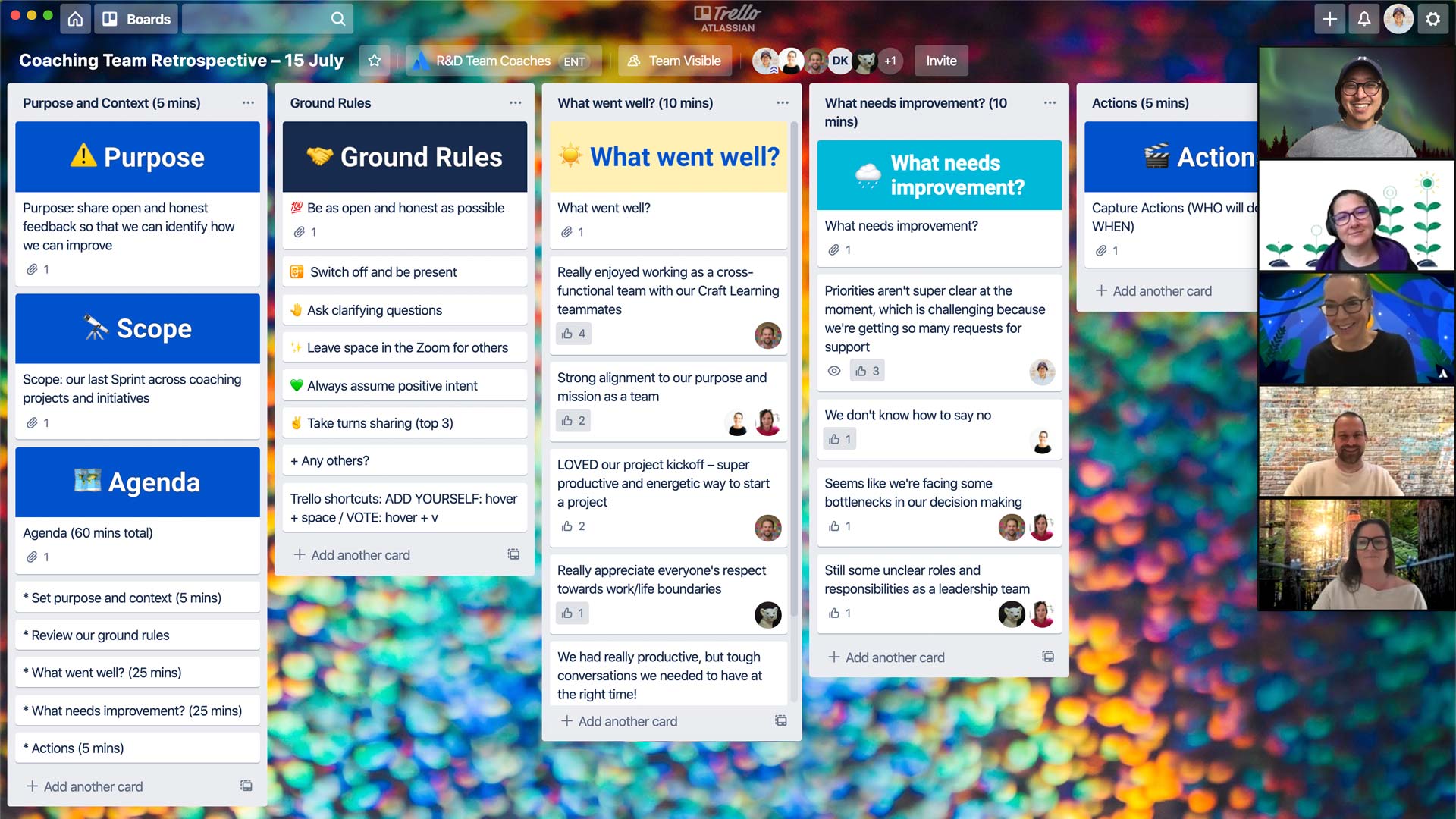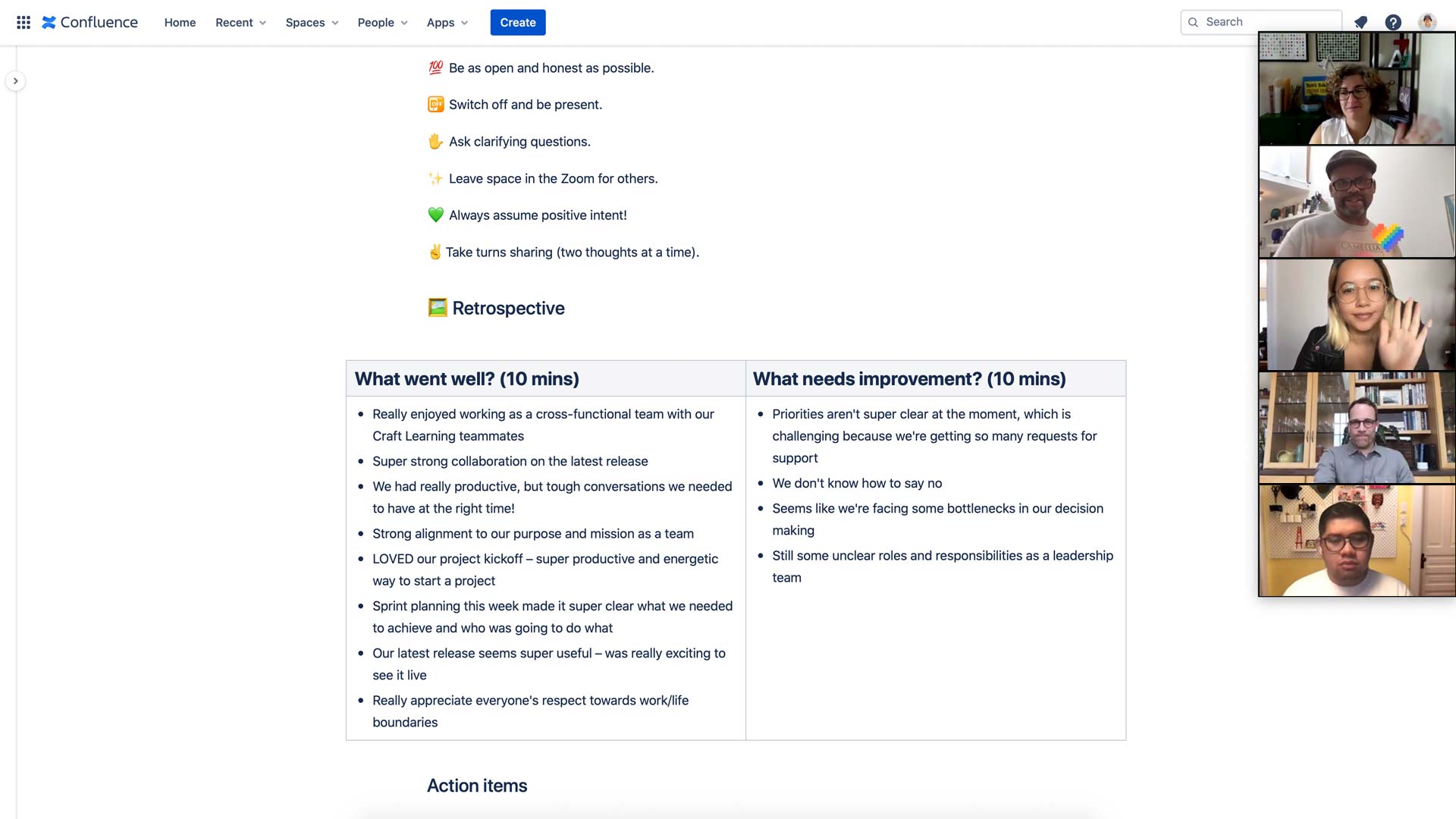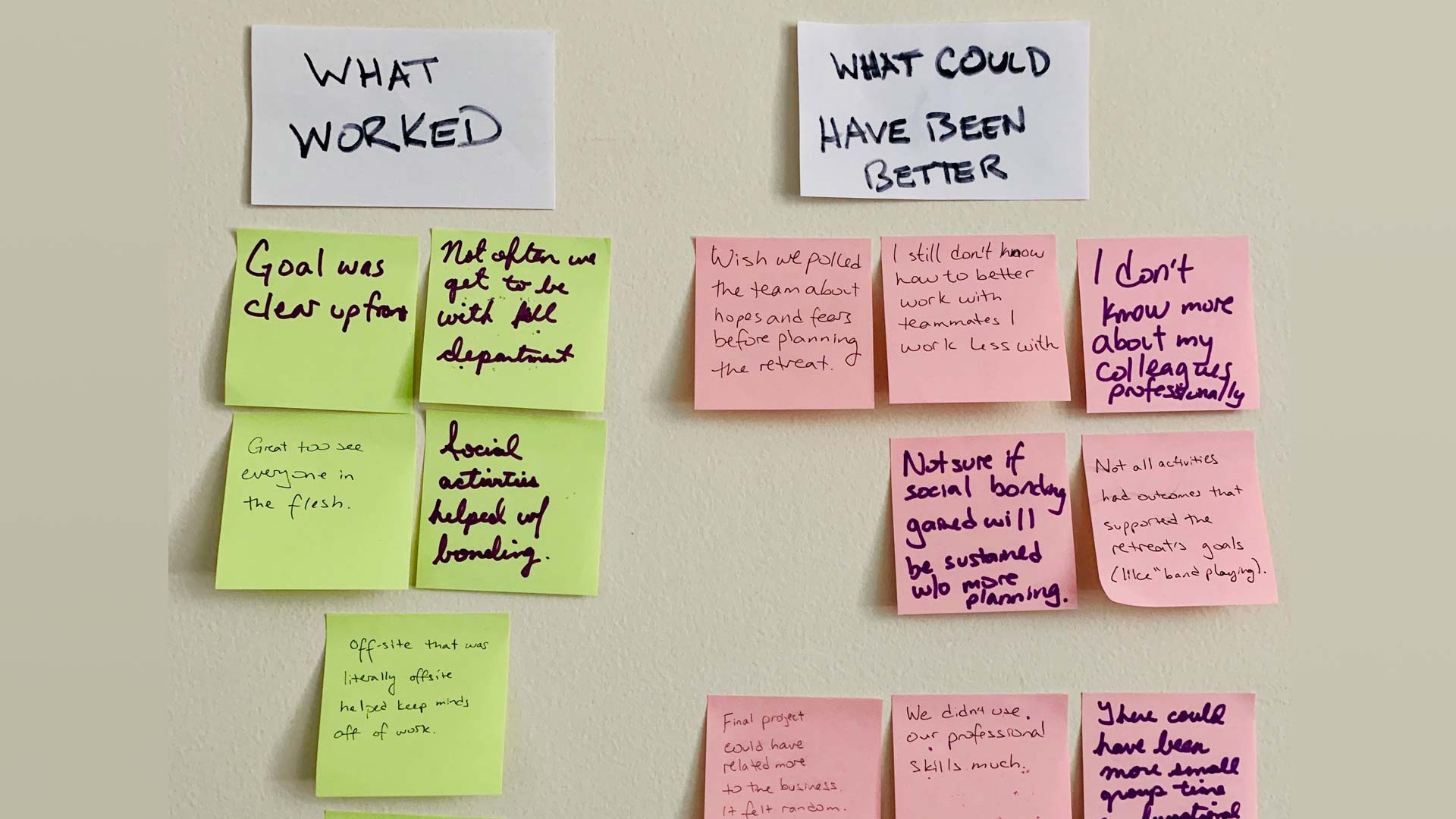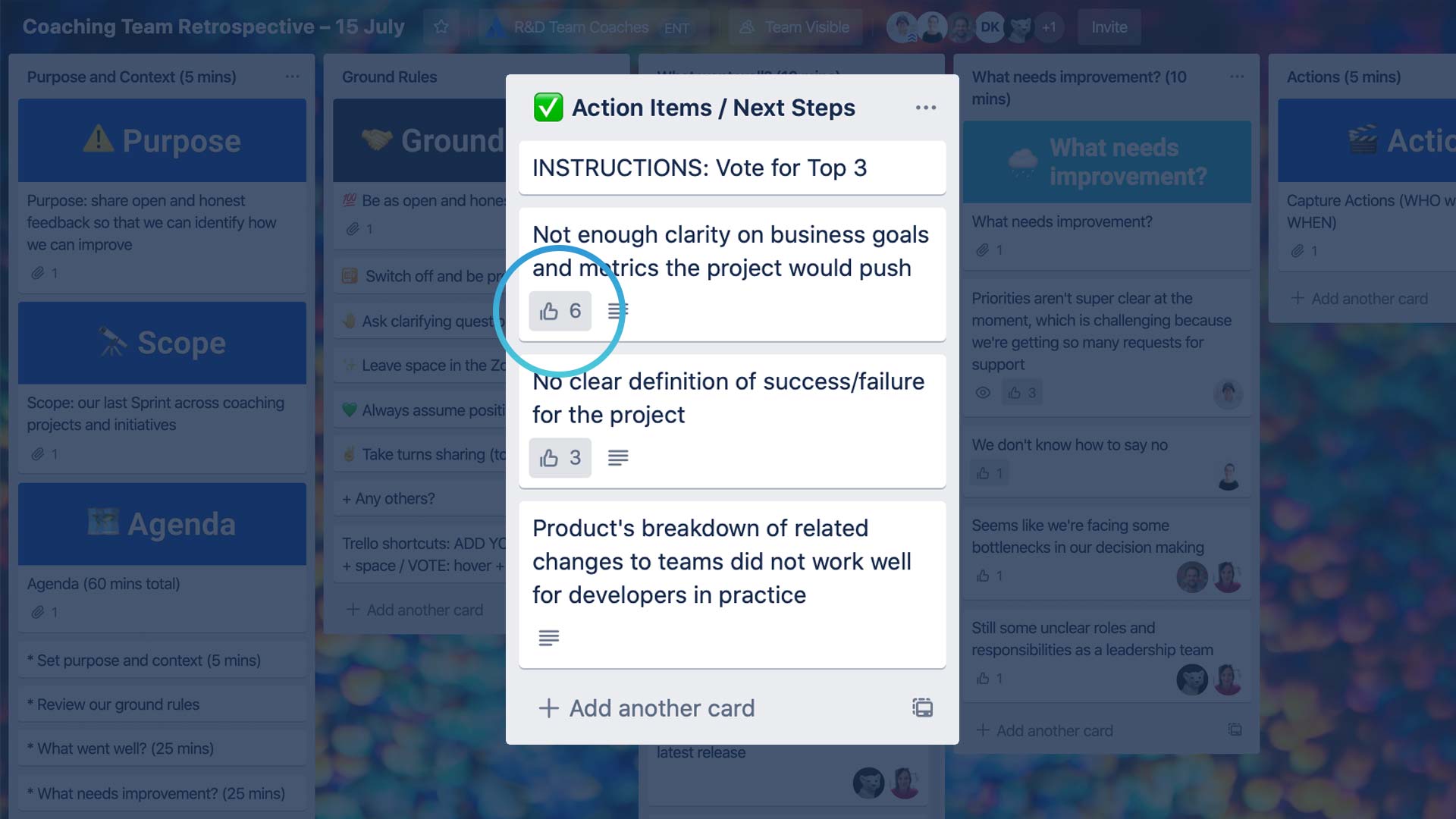Vergaderingen op basis van pagina's
Vergaderingen op basis van pagina's zijn effectiever en productiever, omdat ze de deelnemers helpen om het doel, de scope, de verwachte resultaten en de belangrijkste discussiepunten van de vergadering over te brengen.
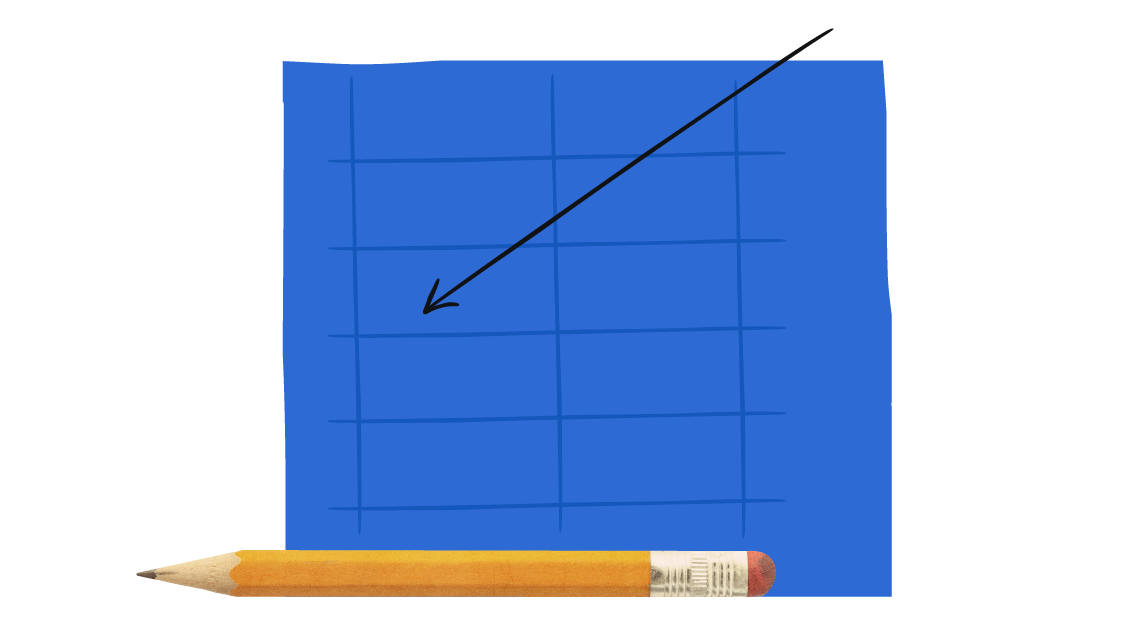
Voorbereidingstijd
30 m
LOOPTIJD
60 m
Personen
1
SAMENVATTING VAN 5 SECONDEN
- Maak je sjabloon voor een vergadering op basis van een pagina en deel deze in je uitnodiging voor de vergadering.
- Begin de vergadering door iedereen de pagina in stilte te laten lezen.
- Gebruik je pagina om de vergadering te faciliteren, beslissingen te documenteren en je resultaten te delen.
WAT JE NODIG HEBT
- Platform om te kunnen videobellen waarmee je je scherm kunt delen.
- Digitale samenwerkingstool.
Middelen voor spellen
Zo organiseer je een vergadering op basis van een pagina
Gebruik dit sjabloon en dit facilitatieproces om je volgende vergadering maximaal te benutten.
Wat is een vergadering op basis van een pagina?
We definiëren een pagina als een schriftelijk document van hoge kwaliteit waarin de benodigde context, doelen en belangrijke beslissingen worden beschreven.
De deelnemers wordt gevraagd om de pagina aan het begin van de vergadering te lezen en er gedurende de hele vergadering naar te verwijzen. Zo is iedereen op elkaar afgestemd. Dit zorgt voor een effectievere vergadering die:
- Meer duidelijkheid creëert
- Informatie effectief overbrengt
- Het besluitvormingsproces vergemakkelijkt
-
Werk in beweging houdt
Deelnemers kunnen tijdens het lezen ook hun eigen opmerkingen aan de pagina toevoegen, wat kan helpen om een duidelijkere en meer inclusieve discussie te creëren. Dit voegt een unieke dynamiek toe aan vergaderingen op basis van pagina's die bij traditionele bijeenkomsten vaak ontbreekt.
Hoe effectief zijn vergaderingen op basis van pagina's?
Het Team Anywhere Lab van Atlassian, een groep gedragswetenschappers, heeft met Atlassian-teams de effectiviteit getest van het gebruik van vergaderingen op basis van pagina's. Dit zijn enkele belangrijke bevindingen:
- Mensen die deelnamen aan vergaderingen op basis van pagina's voelden zich 29% meer energiek na een vergadering en 23% minder gefrustreerd, vergeleken met de controlegroep.
- Bij 85% van de vergaderingen op basis van pagina's is het doel bereikt, tegenover 69% bij de controlevergaderingen.
- Mensen die deelnamen aan vergaderingen op basis van pagina's zagen hun vergaderingen als een aanzienlijk betere besteding van hun tijd.
Wanneer moet je een vergadering op basis van een pagina organiseren?
Samenwerking via een pagina is het krachtigst wanneer je beslissingen moet nemen of consensus moet opbouwen.
Hier zijn enkele gevallen waarin een vergadering op basis van een pagina nuttig kan zijn:
- De voortgang van een project of situatie is tot stilstand gekomen en je moet de zaken op orde krijgen.
- Je hebt een beslissing nodig van je team of belanghebbenden.
-
Je hebt input of feedback nodig over iets; een idee, een werkitem, de scope van het project van een klant of iets anders.
5 voordelen van vergaderingen op basis van pagina's
Nog niet overtuigd? We zetten de voordelen voor je op een rijtje. Vergaderingen op basis van pagina's kunnen het volgende verbeteren:
- Duidelijkheid: schriftelijke communicatie helpt om denkwijzen te verbeteren en de focus te houden op wat belangrijk is. Een goed geschreven pagina brengt hiaten in het gedeelde begrip aan het licht (en overbrugt die hiaten). Tot slot helpt de pagina ook bij de afstemming tijdens hybride en virtuele vergaderingen.
- Inclusiviteit: de opmerkingenfunctie biedt iedereen gelijke kansen om mee te denken en ervoor te zorgen dat de luidste stem in de (virtuele) kamer niet de enige stem is die wordt gehoord.
- Transparantie: beslissingen en beweegredenen zijn duidelijk gedocumenteerd en toegankelijk, zodat niemand hoeft te raden wat diegene moet doen of waarom.
- Duurzaamheid: in tegenstelling tot verbale of op dia's gebaseerde vergaderingen wordt bij vergaderingen op basis van pagina's een schriftelijk document van de interacties bewaard. Zo'n document kan op elk moment worden geraadpleegd en gebruikt als basis voor toekomstige beslissingen.
- Efficiëntie: het bieden van context gaat sneller, waardoor waardevolle vergadertijd overblijft om problemen op te lossen en samen beslissingen te nemen.
1. Beslis of een vergadering op basis van een pagina de juiste beslissing is
Geschatte tijd: 5 MIN.
Vergaderingen die zijn gebaseerd op pagina's zijn het meest effectief als je een beslissing moet nemen of ergens een consensus over moet bereiken. Hier zijn enkele vragen die je jezelf kunt stellen:
- Probeer je vooruitgang te creëren bij iets dat vastloopt?
- Heb je teamgenoten of belanghebbenden nodig om een beslissing te nemen?
-
Heb je mensen nodig die reageren op of feedback geven op je werk?
Als je een van deze vragen met 'ja' hebt beantwoord, is een vergadering op basis van een pagina de juiste keuze.
Als je eenmaal weet dat een vergadering op basis van een pagina geschikt is, moet je een pagina maken met je favoriete samenwerkingstool. Confluence is hier zeer geschikt voor.
Tip: ken je doelgroep
Je hoeft deze aanpak of dit sjabloon niet voor elke vergadering te gebruiken. De aanpak is het krachtigst wanneer deze wordt toegepast bij besluitvorming of consensusvorming.
2. Stel je eigen pagina samen
Geschatte tijd: 30 minuten
Om de duidelijkheid te verhogen, moet je pagina altijd het doel, de scope, de gewenste resultaten en de belangrijkste discussiepunten bevatten. Idealiter staan deze items helemaal bovenaan, zoals hier:
| Doel/scope van de vergadering | Dit helpt de deelnemers te begrijpen wat voor soort gesprek je wilt voeren, wat voor soort opmerkingen ze moeten maken en welke soorten vragen ze moeten stellen. Bijvoorbeeld:
|
|---|---|
| Resultaten van de vergadering | Wees duidelijk over wat de verwachte uitkomst van de vergadering is. |
| Belangrijke discussiepunten | Zet de belangrijkste discussiepunten op de voorgrond, zodat de lezers weten wat er moet worden besproken. |
Hier is een voorbeeld waarbij de inhoud is inbegrepen:
Onze volgende stap voor DEI-initiatieven
| Doel/scope van de vergadering | Bespreek het probleem/de blocker |
|---|---|
| Resultaten van de vergadering | Stel een plan op dat met het hele personeelsbestand kan worden gedeeld |
| Belangrijke discussiepunten |
|
Je pagina moet worden aangepast op basis van je doelgroep en de doelen van je vergadering. Je kunt er bijvoorbeeld voor kiezen om het volgende toe te voegen:
De probleemstelling: schrijf een memorabele en directe openingszin over het probleem dat je probeert op te lossen. Vertel je lezers de belangrijkste informatie die ze moeten weten.
Achtergrond: leg uit waarom je deze vergadering houdt en waarom de uitkomst belangrijk is! Help je lezer om het belangrijkste deel van je boodschap te vinden met een duidelijke kop, zoals 'Waarom dit belangrijk is', of een andere slimme titel die de aandacht trekt.
- Wat is er tot nu toe gebeurd? Geef context voor lezers die nog niet bekend zijn met het project.
- Geef in het kort een overzicht van trends, historische gegevens, je aanpak en de vooruitgang die tot nu toe is geboekt.
-
Gebruik opsommingstekens om ervoor te zorgen dat je pagina overzichtelijk blijft.
Voorgestelde oplossing: als je een voorkeursoplossing in gedachten hebt, moet je deze delen! Geef duidelijk aan welke oplossing je aanbeveelt en waarom.
- Gebruik gegevens om je keuze te beargumenteren.
- Identificeer eventuele aannames en geef uitleg over je gedachtegang.
-
Creëer duidelijkheid over de zaken waarvoor nog meer informatie nodig is.
Volgende stappen: wat zou je graag zien gebeuren na de vergadering? Dit is vooral handig als je weet dat de vergadering het probleem niet volledig zal oplossen.
Een sectie met veelgestelde vragen kan een fantastische manier zijn om veelgestelde vragen snel en van tevoren te beantwoorden.
Onze volgende stap voor DEI-initiatieven
Probleemstelling
De afgelopen maand hebben we een aantal gesprekken gevoerd met individuen, teams en groepen over hoe we de diversiteit verder kunnen vergroten.
Achtergrond
Waarom dat belangrijk is: we zijn het er allemaal over eens dat we een sterke DEI-basis hebben, en die willen we gebruiken om de voortgang te versnellen.
Voorgestelde oplossing
Het resultaat: we streven naar drie belangrijke doelen voor volgend jaar:
- Lanceer een Emerging Leaders-programma
- Vergroot de diversiteit op alle niveaus, met name in het managementteam
- Zorg voor nog meer transparantie in ons wervingsproces.
Volgende stappen
Hoe het werkt: het People-team stelt voor elk doel een plan op en deelt dat deze week met al het personeel. Neem contact op met iedereen in het team als je ideeën of suggesties hebt.
Als je pagina eenmaal is aangemaakt, zorg er dan voor dat je deze opneemt in de uitnodiging voor de vergadering voor de deelnemers.
3. Faciliteer je vergadering op basis van een pagina
Geschatte tijd: 20 MIN.
Begin met het delen van het doel van de vergadering om de deelnemers te informeren (of eraan te herinneren) waarom ze er zijn. Leg uit wat je verwacht van hun deelname en vergeet niet dat een vergadering op basis van een pagina misschien een nieuwe ervaring voor hen is.
Laat je publiek vervolgens de pagina in stilte lezen om ze de kans te geven de boodschap van je pagina te begrijpen en zich voor te bereiden op ideeën of oplossingen voor problemen. Je publiek zal profiteren van de heldere mening van anderen en zal de volledige context van de vergadering begrijpen.
- Geef je publiek vijf minuten of langer de tijd om de pagina te lezen, afhankelijk van hoe gedetailleerd je pagina is.
-
Laat je publiek opmerkingen plaatsen en op dingen stemmen die ze live willen bespreken.
Tot slot, ga de discussie aan! Gebruik de pagina en de toegevoegde opmerkingen als leidraad voor je vergadering.
4. Neem een beslissing of vervolgstappen (en noteer wie daar verantwoordelijk voor is)
Geschatte tijd: 10 minuten
Om extreem duidelijk te maken of je voorgestelde oplossing is goedgekeurd, moet je voor elke goedkeurder een selectievakje op je pagina plaatsen.
Approver | Yes | No | Notes and conditions |
|---|---|---|---|
@ | |||
@ |
| ||
@ |
|
Probeer je vergadering af te sluiten met een duidelijk resultaat, een oplossing of met de volgende stappen. Als het je doel is om een oplossing te vinden voor een probleem, kun je duidelijkheid hierover stimuleren door een selectievakje voor elke goedkeurder op je pagina neer te zetten.
Als het tijd is om de vergadering af te ronden, vraag je de deelnemers om het vakje aan te vinken als ze het eens zijn met de beslissing. Als ze het vakje nog niet willen aanvinken, kunnen ze redenen opgeven. Deze kunnen je helpen bij je volgende stappen.
Onze volgende stap voor DEI-initiatieven
Probleemstelling
De afgelopen maand hebben we een aantal gesprekken gevoerd met individuen, teams en groepen over hoe we de diversiteit verder kunnen vergroten.
Achtergrond
Waarom dat belangrijk is: we zijn het er allemaal over eens dat we een sterke DEI-basis hebben, en die willen we gebruiken om de voortgang te versnellen.
Voorgestelde oplossing
Het resultaat: we streven naar drie belangrijke doelen voor volgend jaar:
- Lanceer een Emerging Leaders-programma
- Vergroot de diversiteit op alle niveaus, met name in het managementteam
- Zorg voor nog meer transparantie in ons wervingsproces.
Volgende stappen
Hoe het werkt: het People-team stelt voor elk doel een plan op en deelt dat deze week met al het personeel. Neem contact op met iedereen in het team als je ideeën of suggesties hebt.
Approver | Yes | No | Notes and conditions |
|---|---|---|---|
@Mia Snyder | I’m comfortable as long as the recruiting team is looped in. | ||
@Will Allen |
| ||
@Jie Song |
|
5. Werk je pagina bij om de feedback weer te geven
Geschatte tijd: 10 minuten
Na de vergadering kan je pagina voortleven als een artefact, met alle opmerkingen en beslissingen die over je project zijn gemaakt. Het kan fungeren als een permanente, duurzame informatiebron waarnaar op elk moment kan worden verwezen.
Er zijn een aantal dingen die je kunt doen om dit doel te bereiken:
- Zet alle beslissingen bovenaan de pagina. Vermeld zowel wat er werd besloten als waarom. Dit maakt het gemakkelijk om in één oogopslag te zien wat het resultaat van de vergadering was.
- Wees toekomstige vragen voor. Als je deelnemers vragen hadden die niet op de pagina worden beantwoord, kan het handig zijn om dezelfde vragen voor toekomstige lezers te beantwoorden.
- Versterk ideeën. Sommige feedback heeft misschien ideeën opgeleverd over hoe de aanbeveling op de pagina kan worden verbeterd of versterkt. Het kan zinvol zijn om deze rechtstreeks aan de pagina-inhoud toe te voegen.
Op [datum] kregen we goedkeuring om verder te gaan met [aanbeveling]. Hiervoor is gekozen vanwege [redenen].
Tip: werk je pagina bij
Vergadering op basis van een pagina resulteren in kwalitatief betere, duurzamere informatie. In tegenstelling tot een vergadering die mondeling of met dia's wordt gefaciliteerd, leeft na een vergadering op basis van een pagina het artefact van de pagina voort.
Daarom is het de moeite waard om na de vergadering wat tijd te investeren om de pagina bij te werken om weer te geven wat er tijdens de vergadering is gebeurd.
Opvolgen
Share out
Zodra je de pagina hebt bijgewerkt, deel deze dan met de deelnemers aan de vergadering en eventuele belanghebbenden die op de hoogte moeten worden gesteld van de beslissing, maar die niet aanwezig waren bij de vergadering.

Heb je nog vragen?
Praat met andere teamdraaiboekgebruikers van Atlassian, krijg antwoord op je vragen of geef feedback.
Andere spellen die je misschien leuk vindt
Cultuur
Team-gezondheidsmonitor
Evalueer de gezondheid van je team en stel een verbeteringsplan op.
Vergaderingen
Wekelijkse teamupdates
Deel hoe het ervoor staat zonder weer een vergadering te plannen.
Communicatie
Gebruikershandleiding
Vertel je teamgenoten hoe ze het beste met je kunnen samenwerken.
Nabespreking
Retrospectief
Zorg voor een veilige omgeving om te bespreken wat wel werkte en wat niet.
Blijf up-to-date
Ontvang het laatste advies over spellen en werk als je je inschrijft voor onze nieuwsbrief.




